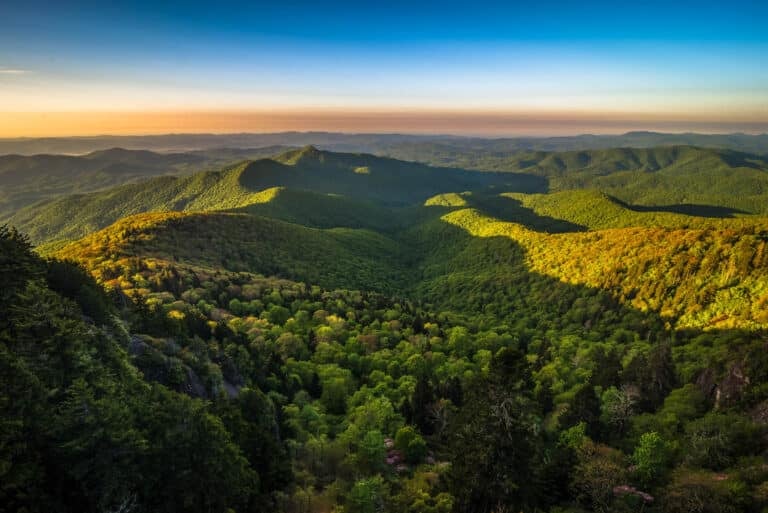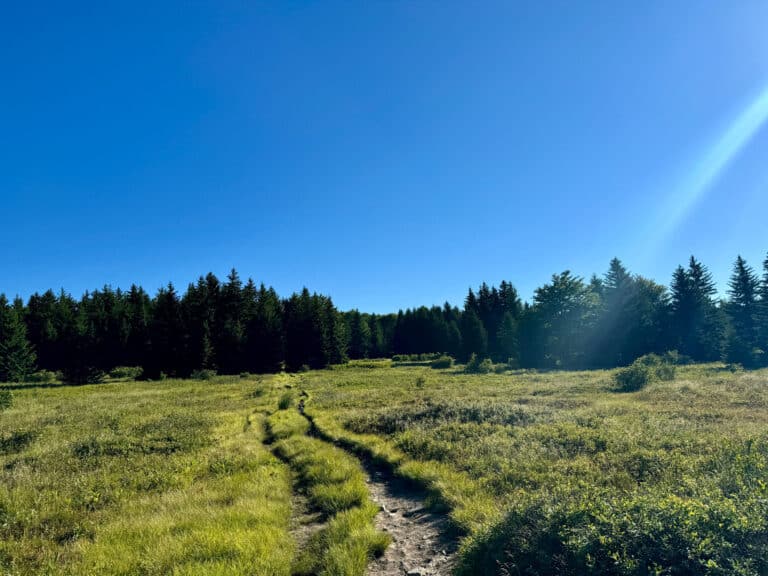Climbing creeks and rappelling waterfalls is a new southern obsession
It happens fast. I rappel off the edge of the waterfall, and the rope gets wrapped around my hand, slamming my body into the wet rock face. My hand is cut and bleeding. Water pounds my helmet and shoulders. I kick and scratch with my feet until I find a foothold, which enables me to free my hand from the taut rope. I continue the rappel, bloody and banged up, but alive and smiling.
My love for cascading has ensnared me in a number of uncomfortable situations over the years. I’ve made nice with a nest of rattlesnakes while exploring West Virginia’s Blackwater Canyon. I’ve lost a toenail on the Yellowstone Prong. I’ve scrambled hand over hand in the dark trying to escape a gorge I underestimated off the Blue Ridge Parkway.
Cascading is so simple a sport, you could almost get away without calling it a sport. It is the practice of moving up or down a waterway. Enter a stream, then boulder hop, swim, jump, and scramble forward. If you come across a waterfall, you rappel. If cascading sounds a lot like canyoneering, that’s because it is. Canyoneering is the practice of descending a waterway inside a slot canyon. Cascading is the same practice applied to gorges, which are typically wider than slot canyons and covered with more vegetation.

Gorges in the Southeast are also typically brimming with water, whereas a slot canyon in Utah, the epicenter of canyoneering, might be predominantly dry. Guides and canyoneers in the Pacific Northwest, Europe, and South America have taken to calling their adapted version of the sport “cascading” to distinguish between the two, but it could be argued that there is no real difference between them other than the setting.
“We call our trips canyoneering because that’s a word people know and understand,” says Andy Nichols, owner of Shenandoah Mountain Guides, which offers trips on creeks throughout Virginia and West Virginia, including the Shenandoah National Park’s popular White Oak Canyon. “But technically, what we’re doing isn’t canyoneering. We don’t have true slot canyons here. But the obstacles are the same, and the skills you use to traverse the rivers are the same: swimming, rock hopping, and waterfall rappels.”
Regardless of the name you give it, the practice of getting off trail and moving up or downstream is an adventure that taps into the pure joy of being immersed in nature. You swim, you jump, you climb, you scramble. It’s a primal sport that mimics the sort of play we did as children, scampering through the creeks and woods.
“You can do this on any stream in the Blue Ridge,” Nichols says. “This is low-tech stuff. You just need the right topography: a combo of water with significant upland.”
Look at any topo map: where there’s a creek and a ridge, there’s cascading potential. If one of those blue creek lines runs perpendicular to a series of black topo lines, that means the creek is full of waterfalls and fun rappelling potential awaits, especially if the blue line is sandwiched by a congruence of close topo lines on either side.
Even more surprising than the amount of cascading potential in the Southern Appalachians, is the fact that very few people are doing it. Sure, a fraction of the population has been exploring creeks in this manner for decades without giving it a name—some locals call it “creek stomping”— but by and large, most hikers would never consider walking up a creek to see what’s beyond the next bend.

“In the East, people are slowly starting to recognize that we have these gorges that are in really difficult, almost inaccessible places that are ripe for exploration,” says Jeremy Tooley, cascading guide for Shenandoah Mountain Guides.
Exploration is exactly what led me to my bloody rappel on the 65-foot Pinnacle Falls in South Carolina. Pinnacle sits on a private creek that drops off the Blue Ridge Escarpment, where the mountains suddenly give way to the piedmont below. Eventually, the creek mellows out as it drains into Lake Jocassee, but up high, where the topography is dramatic, the waterway holds a half-dozen waterfalls, all packed into a mile-long stretch of water. Unlike most other boulder-choked creeks in the Southern Appalachians,
Pinnacle is full of ledges where water tumbles over long sheets of slick granite, often covered with a thick carpet of moss.
We rappel each of the waterfalls, with guide Joe Moerschbacher running ropes through anchors around trees. The drops get bigger as we move downstream, and between the rappels, we wade and scramble through the water, occasionally dropping to all fours to crawl beneath the thick canopy of rhododendron. Dropping off a multi-story waterfall on a skinny climbing rope is dramatic, but the joy of the sport lies in between the rappels: the mossy canyon walls, the solitude of the creeks, the rock-hopping, bushwhacking, and waist-deep wading.
There’s a lot of slipping and falling—cascading is a full contact sport—and then I get tangled on the final seven-story waterfall. But aside from rappelling waterfalls (which you can usually scramble around), you need more common sense than technical skill in order to traverse most of the gorges in the Southeast.
“There’s no rocket science to this,” says Andy Nichols. “When I was a kid, this is how we spent our afternoons. What’s cooler than following a creek upstream? This is poor-boy fun.”

BEGINNER FRIENDLY CASCADING TRIPS
Big Fiery Gizzard Creek, Tenn.
Tackle the first 4.5 miles of the Fiery Gizzard Trail between Gundy Forest Natural Area and Raven Point, and you’ll get a solid three miles of cascading through the Big Fiery Gizzard gorge. The trail drops into the gorge, enabling you to rock hop, swim, and jump your way downstream. You’ll pass impressive waterfalls, sheer rock walls, deep pools, and boulders the size of McMansions.
Red Creek, W.Va.
Red Creek drains most of the Dolly Sods in the mountains of West Virginia. It’s packed with small waterfalls that make fun, short rappels, but there’s nothing you can’t scramble around if you don’t have the requisite rope skills. The adjacent Red Creek Trail crosses the creek a number of times, providing relatively easy access and escape routes. Swimming holes, boulders, and picturesque drops await.
Cedar Run, Va.
Cedar Run has some of the most spectacular waterfalls and popular swimming holes in Virginia’s Shenandoah National Park, but the true fun comes when you try to navigate the river bed between these popular spots. The entire run is characterized by massive boulders, stretches of walled out canyons, and picturesque cascades. Cedar Run Trail crosses the creek, enabling easy access to the popular swimming holes. Ditch the trail and move up or downstream away from the crowds.
Flat Laurel Creek, N.C.
Flat Laurel is anything but flat. The creek is choked with large granite boulders and drops almost a thousand feet from the Parkway to highway 215 in a series of cascades and small waterfalls. An old, unmaintained trail descends into the gorge from Flat Laurel Creek Trail, providing relatively easy access for a bottom up exploration. The gorge walls are steep, but not impossible to climb if the weather turns or you find yourself in front of an obstacle that’s too risky to navigate. Plus, the creek is near a popular trail system along the Blue Ridge Parkway, so help isn’t too far away if something goes wrong.
GO WITH THE PROS
To get the full cascading experience, from rock scramble to waterfall rappel, check out Shenandoah Mountain Guides (teamlinkinc.com) for gorge trips in Virginia and West Virginia, and Pura Vida Adventures (pvadventures.com) for trips in North Carolina.

DO IT YOURSELF
Unless you’re planning on rappelling waterfalls, you don’t need a guide to go cascading on most Southern Appalachian creeks. With common sense and good fitness, you can get off trail to explore some of the South’s most dramatic gorges. Here are tips for proper cascading from Jeremy Tooley, lead guide for Shenandoah Mountain Guides:
Don’t Go Alone
If you get hurt, it could be a long time—perhaps years—until someone finds you.
Have Good Footwear
The best footwear is a sandal or shoe with rubber specifically designed for wet rock. Look for footwear that has the same kind of rubber sole that’s used for climbing shoes. The company 5.10 even makes a canyoneering-specific shoe.
Plan For a Night Out
Bring a dry bag with a dry layer of clothes, snacks, and an emergency kit.
Move Upstream
Cascading from bottom to top can make it easier to traverse steep terrain, and might be smart if you’re not planning on rappelling any waterfalls.
Follow The Sun
If you can, pick a creek that gets some sun. The wider the gorge, the more sun the creek bed will typically get. Not only will the adventure be warmer, but the creek will be less slippery, as algae tends to grow on rocks in the shade.







